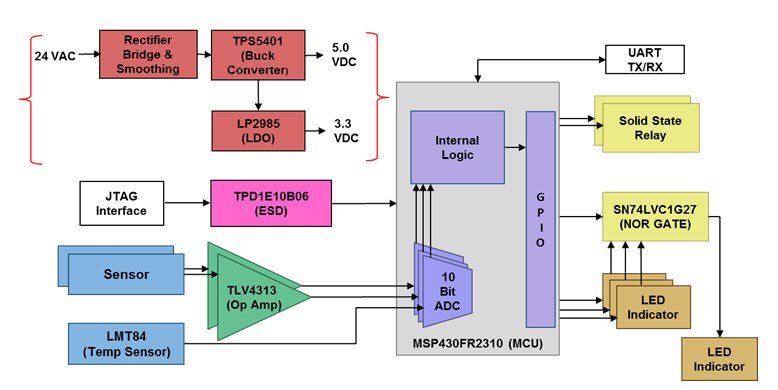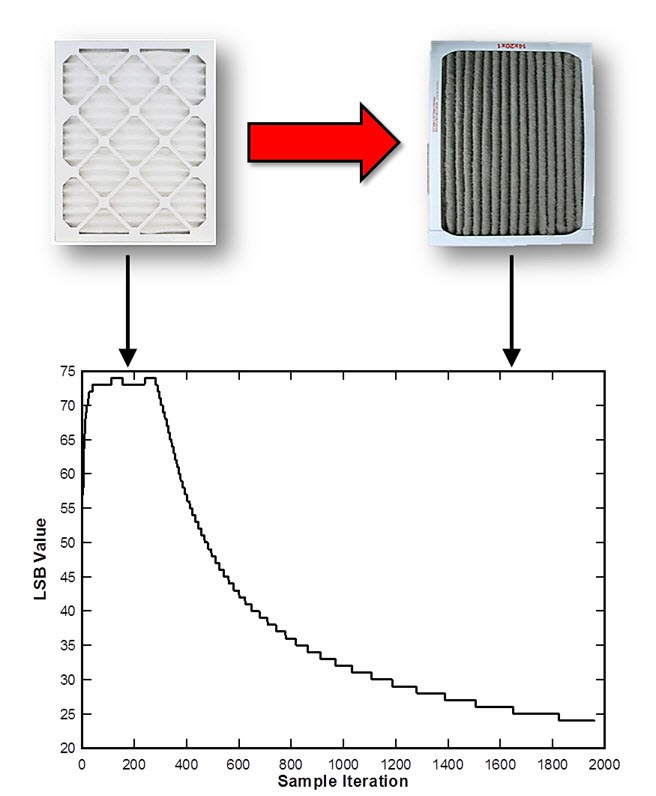SSZTAM8 november 2016 CSD19537Q3 , LMT84
As the wheels of technology continue to roll forward, advances in the HVAC industry are shifting away from historically mechanical improvements and innovations to more electronic-based advances. One of the emerging technologies found in systems today is focused on predictive maintenance for maximizing energy efficiency.
One of the easiest ways to use predictive maintenance technology to increase energy efficiency is through the use of airflow-monitoring devices. These devices can alert homeowners of airflow issues within an HVAC system and even indicate when to change the air filter. This rapidly growing market is changing the way we think about filter replacement.
In the past, typical residential HVAC systems had ordinary thermostats with a “timer,” allowing users to select the filter change cycle length in days. Some companies use system run time as an indicator of when to change the filter. Unfortunately, these solutions neglect to address the rudimentary need for filter replacement – a decline in system efficiency.
Every home is different, as is every HVAC system’s environment. Some homeowners may be home very infrequently, and may use the air conditioner very rarely. Others may work from home, have pets, live in cooler environments or have a highly trafficked tile floor next to their return air vent, which is the case for me. Each situation can vary the lifetime of your typical filter drastically, depending on particulate debris buildup and how often your system runs. Unfortunately, these varying conditions seem to have slipped under the innovation radar for HVAC product companies – that is, until now. Incipient companies are now developing filter-monitoring systems based on airflow efficiency and pressure drop across the filter, eliminating the consumer guesswork that goes into maintaining system integrity and energy efficiency from a filter standpoint.
The HVAC Coil Airflow Sensor Reference Design for Predictive Maintenance in Air Filter Replacement demonstrates an efficient and low-cost method of airflow-degradation monitoring with the addition of evaporator coil freeze prevention. This system connects directly to the air handler’s 24VAC transformer and continuously polls the temperature of the evaporator coil air, as well as the differential airflow from the filter to the air-handler blower. From this data, the system can determine from the MCU logic whether there is adequate airflow across the evaporator coil through the filter. Figure 1 shows this reference design’s system block diagram.
 Figure 1 HVAC Coil Airflow Sensor
System Block Diagram
Figure 1 HVAC Coil Airflow Sensor
System Block DiagramIf a coil freeze prevents heat transfer from the air to the evaporator, the system has the capability to trigger a solid-state 24V relay that shuts off the condenser, preventing more refrigerant from being pushed through the expansion valve. A secondary relay ensures that the blower fan continues to push ambient air across the coil to accelerate the temperature increase to an acceptable operation range, while indicating to users a problem with the system’s airflow. These relays are identical to those used in the Solid State Relay 24V AC Switch with Galvanic Isolation Reference Design.
For airflow monitoring, two low-cost piezoelectric vibration sensors, used in conjunction with a charge amplification/rectification filter and MCU, determine the airflow differential between the locations of each sensor. This provides the ability to extract system issues based on fluctuations in the differential during a typical cooling cycle.
Figure 2 shows data from an actual HVAC system test using the HVAC coil airflow sensor reference design. The filter conditions in this test began with a typical clean filter. During this condition, the differential is holding steady between 70-75 LSB out of 1,024 total LSB values. After the filter is blocked, the differential between the two piezoelectric sensors drops, settling around 24 LSB. You can see that the span of values on the y axis rapidly shifts when the filter is first blocked, then increases in sample value (x) duration as the value reaches the lower limits of the differential scale.
 Figure 2 TIDA-01070 HVAC Coil Airflow
Sensor Reference Design Test Results
Figure 2 TIDA-01070 HVAC Coil Airflow
Sensor Reference Design Test ResultsFrom this data, you can set a threshold – a point between the clean filter and the completely blocked filter – in which to alert users of a necessary filter change.
I mentioned earlier that every system is unique, as is their respective environment of operation. So how can you design a system to address this system entropy? I’ll answer that question in the next installment of this three-part series.
Additional Resources:
- Learn more about building automation solutions from TI
- View all building automation reference designs
- Watch the webinar: "Energy efficient building automation solutions using innovative wireless sensing"
- Read the white paper: Making factories smarter, more productive through predictive maintenance